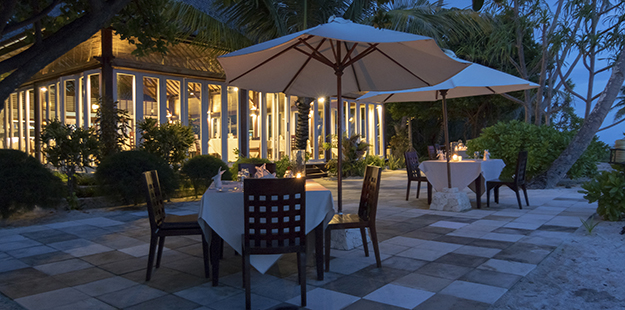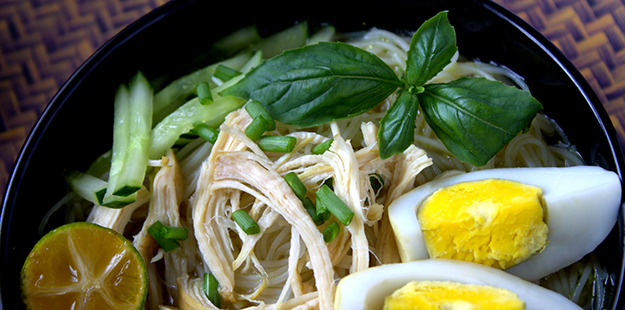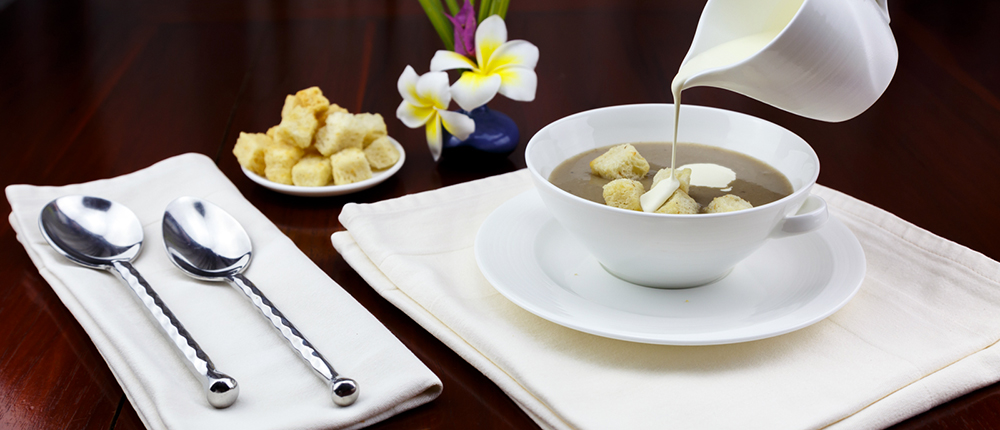A Taste of Wakatobi #2
Wakatobi’s chefs share some of their favorite Indonesian soup and stew recipes
A full day of diving, snorkeling, kitesurfing and beach time can work up quite an appetite. So it’s no wonder that meal times at Wakatobi are everyone’s favorites. Our chefs always serve up a delicious range of international cuisines, along with a variety of regional dishes. Each guest has a personal favorite, but among the perennial crowd pleasers are the savory soups that are a part of each lunch and dinner spread. Among these are a number of Indonesian soups that deliver a welcoming yet palate-friendly blend of spices and local ingredients.

“It was a thrice-daily pleasure to sit outside in the sun or moonlight and enjoy our spectacular Wakatobi meals, with the kiss of the occasional ocean breeze,” says guest Janet Rogers. Photo by Walt Stearns
At Wakatobi, while many were eager to ogle the desert table on their way into the restaurant, I’d get excited when I’d see a ladle,” says guest Janet Rogers. “Mind you, all of the food left a lasting impression, but Wakatobi’s soup is something that soothed my soul, she says. I can’t be sure, but it seemed as if the head chef was keenly aware that I was looking forward to the soup station; being on an island, our exposure to Indonesian culture might be limited, so he was going to share some of it with us through the food. Each night’s soup was from a different region, it’s origin indicated by name and location in Indonesia. Rather than a blend, I noticed these soups were a layering of ingredients – salty, savory, spicy concoctions whose components were assembled with care for each guest. Mei Tek Tek, Soto Ayam, Bakso, Laksa, Oxtail Soup – take your pick – all were uniquely wonderful, and each like a warm hug from the inside out, infused with love and the flavors of Indonesia. We hope to return soon!”

According to Chef Andi, most Indonesian soups can be fitted into a trio of broad categories known as Sotos, Sayers and Sops. Photo by Marco Fierli
Soup’s On
Indonesia has a long and varied tradition of soup making that reflects the diversity of this nation of 6,000 islands and 300 distinct ethnicities. Regional recipes run the gamut from light, broth-based starters to hearty stews that are a meal in themselves. It would take a stack of cookbooks to list all the soups that are enjoyed throughout Indonesia, but according to Wakatobi’s head chef, Andi, most can be fitted into a trio of broad categories known as Sotos, Sayers and Sops. Sotos include a range of spiced meat soups, sayers are vegetable-based stews and a sop, or sup, is generally a dish that blends Oriental or Western influences with local flavors. You’ll find all of these and more on Wakatobi’s menu, but you don’t have wait until your next visit to sample them.
All of the food at Wakatobi is exceptional, but the different soups are some of our favorite items on the menu, especially the chicken soup. It would be nice to have recipes to make at home during the winter months, and to remind us of Wakatobi. We’re going back soon!” – Ledean and Alan Paden
We’ve asked our chefs to share a few of their favorite recipes. All the ingredients can be obtained most anywhere in the world, though depending on where you live a few may require a trip to an Asian market or an order from an online source, it is worth it.

While Soto Ayam is a comforting chicken soup it is also elegant enough for a dinner party, often served during holidays and special occasions. Photo by Wakatobi Dive Resort
Soto Ayam
It seems like the whole world loves chicken soup, and Indonesia is no exception. The dish known as Soto Ayam always contains chicken, and often includes noodles. Beyond that, there is considerable variation from island to island, with recipes ranging from light broths to rich, creamy soups made with a coconut milk base. This version, which is a chef’s favorite at Wakatobi, is on the lighter side, but still hearty enough to make a meal in itself.
“Growing up, Soto Ayam was the soup families made for special occasions like weddings and holidays. To this day, it is still my favorite,” says chef Andi.
Most of the ingredients are readily available in a well-stocked supermarket. Step one is making the soto paste. For this you will need:
8 shallots, peeled and sliced
6 garlic cloves, peeled and sliced
8 pieces of cashew nut
1 tsp turmeric powder
8 lemongrass stalks (use only the white section & chop very finely)
1-½ ounces of fresh Galangal sliced (Galangal is a ginger-like spice found in Asian groceries or available online)
1 ounce fresh ginger, peeled
1 tablespoon roasted coriander seeds
Pinch of sugar
½ cup cooking oil (peanut oil is preferred)
Place all ingredients except the oil into a food processor and reduce into a paste. Add oil to a hot saucepan, transfer the mixture to the pan and saute at medium-high heat, stirring constantly for about two minutes until the oil starts to separate from the paste. Set this mixture aside and assemble the following ingredients.
1 pound cut chicken pieces – legs, thighs or wings
2 quarts water
5 pieces kaffir lime leaves or one tablespoon lime juice
1 cup rice noodles (boiled)
1 cup shredded and blanched cabbage
4 pieces boiled egg
½ cup sliced celery leaves
Add the chicken, water and lime leaves (or juice) to a medium pot, and bring to a boil. Then reduce this to simmer until the chicken is cooked. Remove the chicken, skim off any foam and save the broth. Once the chicken has cooled, remove the meat from the bone, shred and return to the broth. Add the soto paste, simmer until well mixed; then, add the cabbage and rice noodles just prior to serving. Garnish the bowls with boiled egg pieces and celery leaves, and serve with savory condiments such as a sambal relish.


